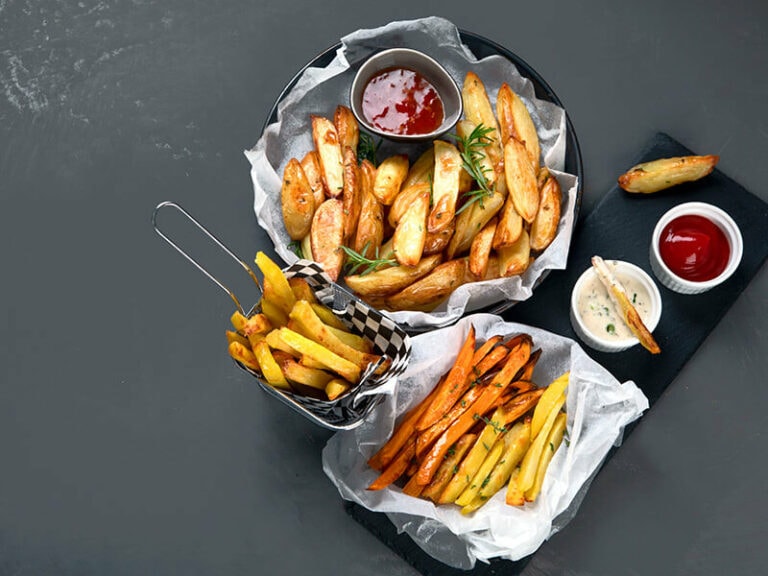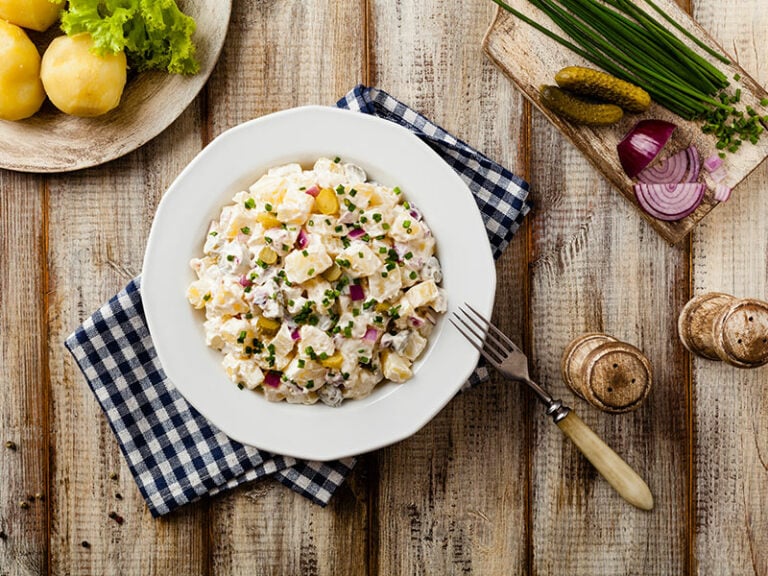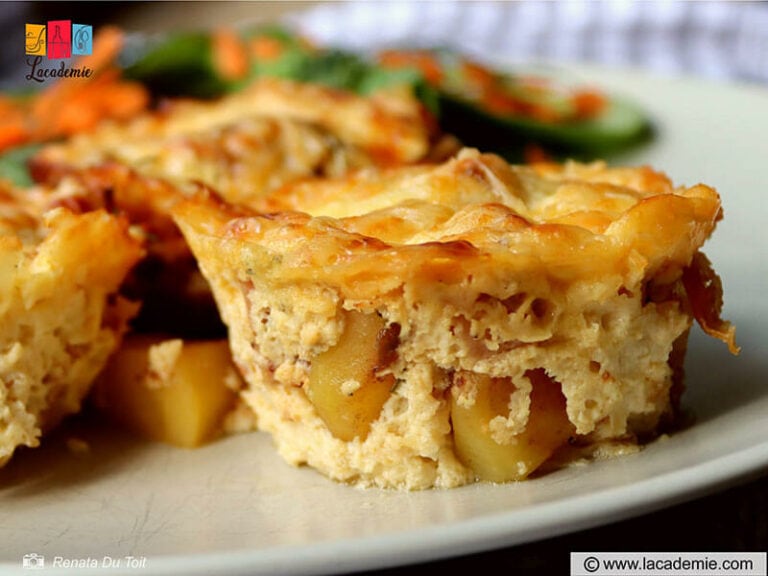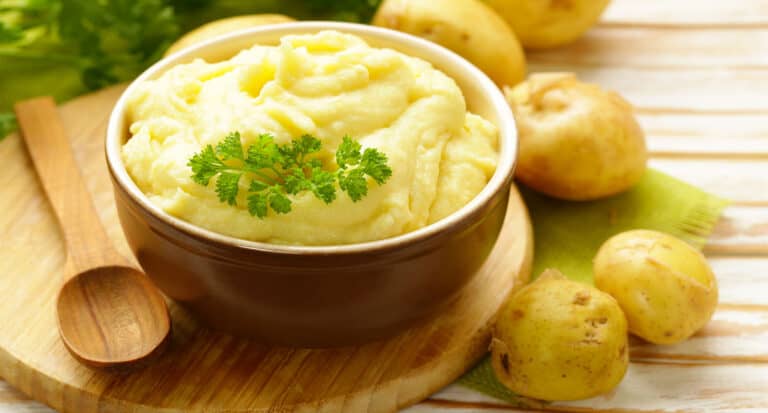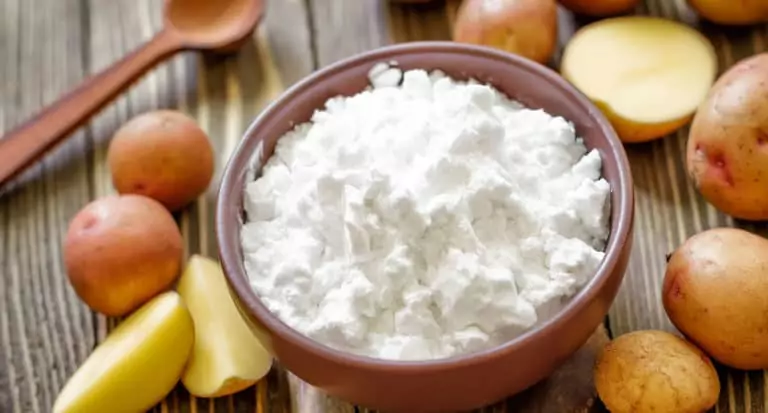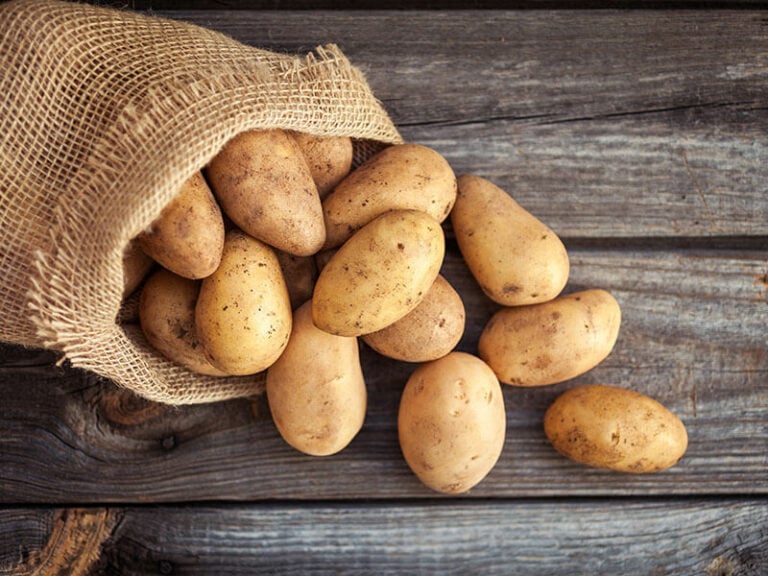How long to bake potatoes at 350°F? Do you have potatoes at home and don’t know how to bake them? If the baking game is not your niche, I’m here to show you every bit of how long to bake the best potatoes ever.
When you understand the basics, none of this should be a problem. Pick the right temperature, set the perfect time, and even manage yourself to maneuver through those weird, unfamiliar situations when baking potatoes. Well, enough rambling. Let’s get started.
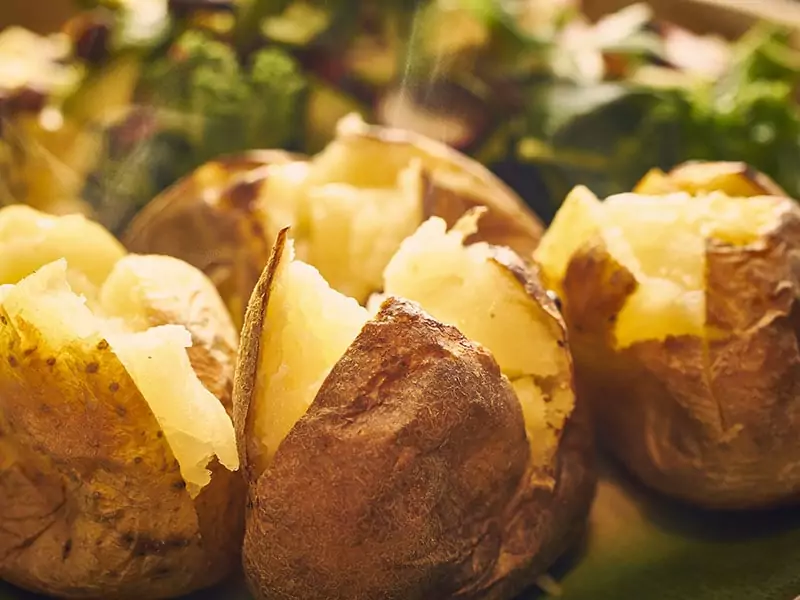
350°F – The Optimal Temperature To Bake Potatoes
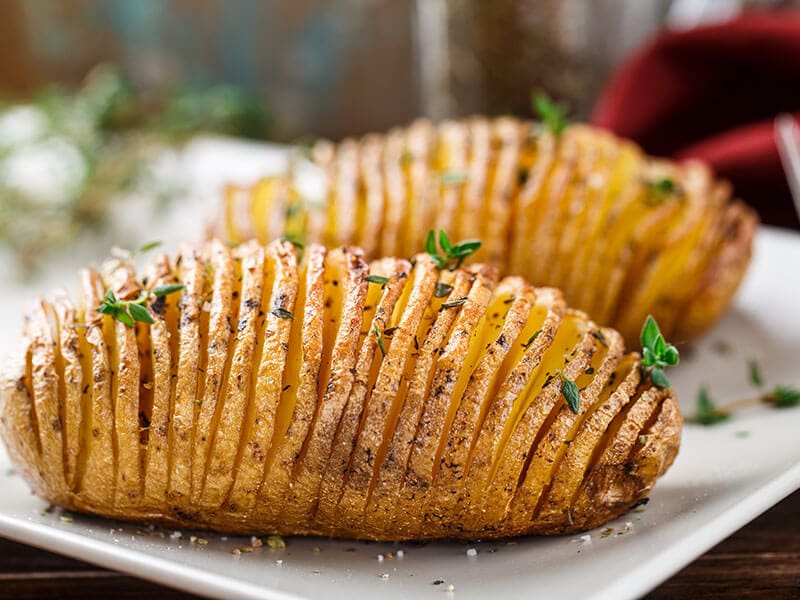
Potatoes are ubiquitous. However, do you know how to turn this familiar, simple tuber into one of the most popular foods in many countries? Well, find out now!
It’s all about baking them, especially at 350°F. Why this temperature, then? Generally, the correct baking time for potatoes at 400°F is 1 hour (1) , and your potatoes will be well done. However, with more patience, you’ll have better results.
At 350°F, your potatoes will take longer to cook, about 80 minutes for medium ones and 10 minutes more for large ones. It might not seem fast, but it’s worth your while, trust me!
In return, your potatoes will be slowly cooked and not dried out. They will have these puffy interiors along with the crispy skins you’d love from perfectly baked potatoes. Besides, at 350°F, the fear of screwing up your potatoes into a tacky mess won’t be around.
Furthermore, baked potatoes contain lots of vitamin C, a little vitamin A, calcium, and iron. They even provide 161 calories from just 173 g of baked potatoes. What a good idea for your breakfast, right? (2)
How Long To Bake Different Types Of Potatoes At 350°F?
Now, put all those trivial facts aside; I’m here to help you with the math for baking your potatoes at 350°F. But not just any potatoes; I’ll show you the best ones to bake for the best texture on the inside and the best appearance on the outside.
Yukon Potatoes
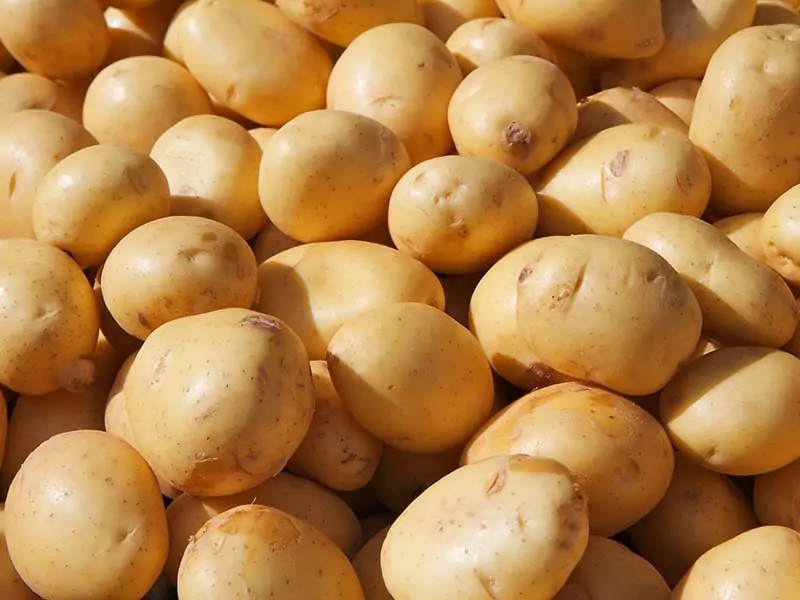
Yukon or Gold Yukon potatoes are famous for their golden-yellow flesh, smooth surface, and thin skin that contains little moisture, making them less fluffy and waxier.
I suggest baking these potatoes for 45 minutes at 350°F to get the best result. They shouldn’t be baked for too long or at a higher temperature. You might burn them or give them a rough texture that is not delicious.
Yukon potatoes might be a little challenging to bake because of their features, such as being less starchy, having thin skin, waxier interior, and medium size. In general, you can bake them, but they won’t be as good as the next one I’m about to show you.
Russet Potatoes (Recommended)
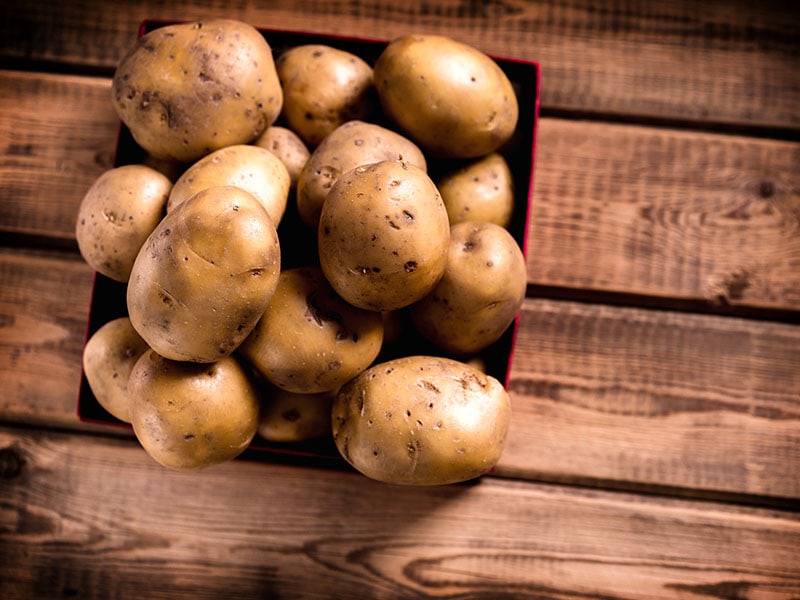
The traditional potatoes used for baking are the Russet. They have thick skin, so it’s easier to get crispy outside. In addition, Russet potatoes are starchy enough to create a fluffy texture when you bake them. (3)
Additionally, because they are usually bigger than others, the potatoes are the ideal meal to eat solo without any side or main dish.
You would want to heat your oven to 350°F and have these tough guys baked for 60 minutes straight. You’re not hearing me wrong! With these settings, your potatoes will be soft and moist in the middle but less crispy on the skin. They seem just about perfect!
If that isn’t your cup of tea, don’t bother! You could turn the heat up to 375°F for 50 minutes to get crispier skin, but they might be drier in terms of texture.
Peek into the secret of baking perfect russet potatoes at 350°F.
Sweet Potatoes
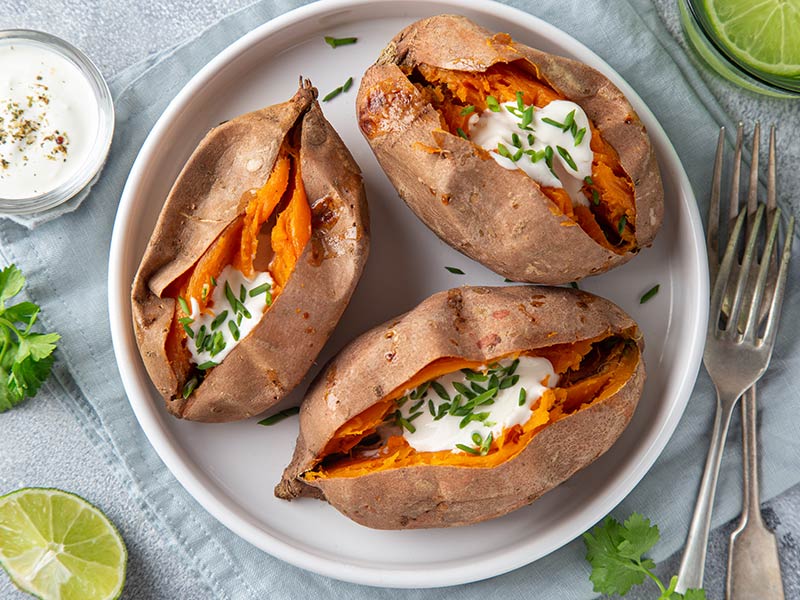
The thing about sweet potatoes is that when you bake them correctly, you can keep their moisture, puffy texture, and sweetness together. Plus, their orange or light-purple flesh is eye-catching. They please your eyes and appetite simultaneously.
Anyhow, I think you should pick those with red or orange skin with orange flesh because those are “moist” varieties of sweet potatoes. They have enough starch to contain moisture, making them puffier and creamier on the inside.
Fire up your oven and set the heat to 350°F. Put in your sweet potatoes and leave them cooked for about 45 minutes or more. Then use a fork or anything sharp to make several holes in each potato.
Even better, if you’re a perfectionist, take out your thermometer to see whether the thickest area of your potatoes reaches the temperature of 205-212°F. Do you know why? At that range, there’s no gritty texture; it’s neither too dense nor too gooey, just “chef kiss” good.
Different Baking Time Based On Potatoes’ Condition
This baking game isn’t always as you expect; sometimes, your potatoes are in the fridge, frozen. Other times you will wonder if you should use the foil to speed up the baking process. No more wondering about baking time. Just read the below section and find out.
Frozen Potatoes
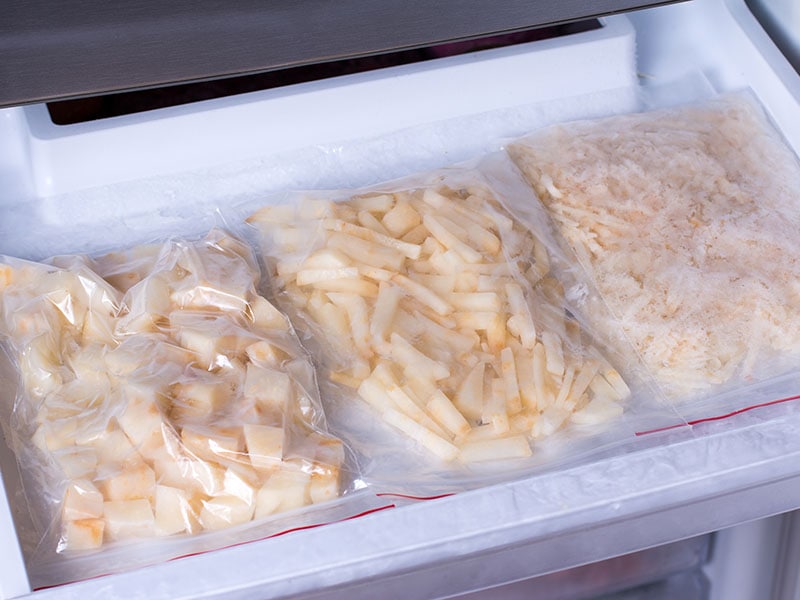
I guess you can tell that frozen cooked potatoes take longer to bake. Whatever you do, don’t skip the defrosting process. Baking frozen potatoes is not recommended because it would ruin and blacken them.
Usually, the time for baking a batch of frozen potatoes is likely to double. And you should bake frozen potatoes for around 70-90 minutes at 350°F. Because, logically, non-frozen potatoes take you 45-50 minutes already.
However, I strongly suggest thawing them first and baking the potatoes the usual way when they’re chilled. Overall, baking frozen potatoes is risky, sometimes you nail it, but sometimes you lose the whole batch.
Just a heads-up, never bake raw frozen potatoes. Imagine your potatoes soaked up with melted water after the baking process. I’ve never found water-soaked potatoes pretty in my life, and I guess you have the same idea.
Tin Foil Or Aluminum Foil Wrapped Potatoes
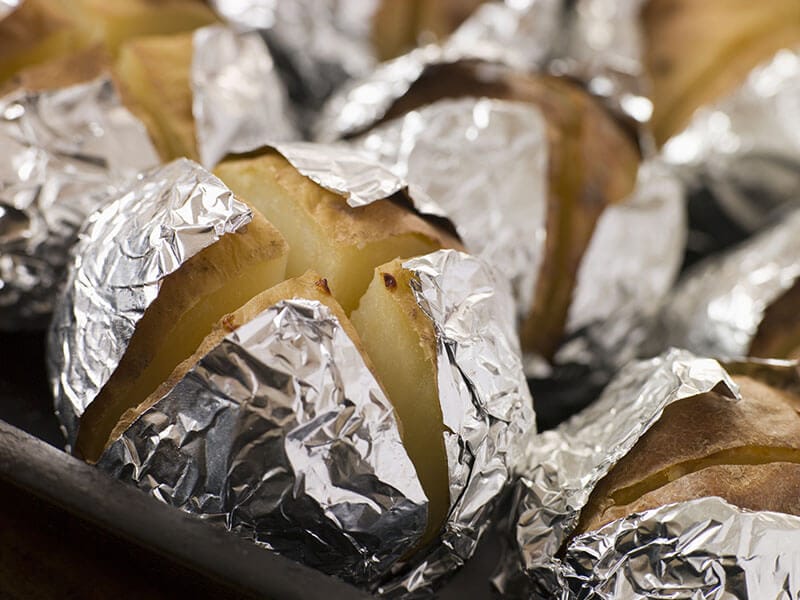
One of the most controversial ideas among potato lovers is to use foil or not for your baked potatoes. Some think the foil traps too much moisture, causing the potatoes to get wet, and others suggest it helps your potatoes cook faster.
Well, that’s fifty-fifty for this “wrapping” story. Some suggest you should never wrap your potatoes with foil of any kind. Your potatoes should be crispy, crunchy on the outside, and tender inside. Foil wrapping will prevent that from happening.
Baking potatoes in foil is a myth as it doesn’t help speed up the cooking process. In addition, using foils is a way to keep your baked potatoes staying hot longer outside the oven.
For the best tenderness, 350°F in 45 minutes at most is all you need; no matter which foils (tin or aluminum) you’re using, that’s the required time for a good potato baked in foil.
How Should You Prepare Your Raw Potatoes?
Here you are at one of the most crucial steps to baking potatoes. Of course, you won’t throw all of them in the oven, skillet, or microwave and heat them; that’s just rude to your potatoes.
Knowing how to prepare them before getting your hands on any next step is a must.
Step 1: Wash
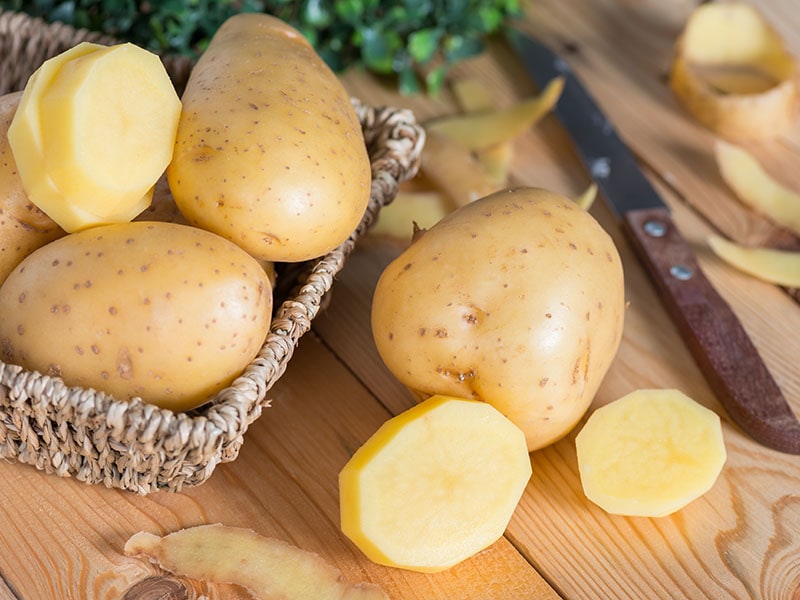
The first thing you do after purchasing potatoes from the supermarket is to clean them. If you’ve already had some at home, make sure that there are no signs of spoilage on those potatoes.
Remove the dirt and residue that sticks on the surface by washing them under a strong water flow. Remember to scrub those unwanted things off your potatoes. Since these are for baking, you will want to keep the peel on them. So try to remove all those pesticides and bacteria for food hygiene.
Step 2: Soaking & Drying
FYI, soaking is the secret to the crispiness of your potatoes, and you would want to soak them overnight (about 8 hours). The top chefs recommend soaking potatoes, so don’t worry about anything.
Drying or rinsing the redundant water out of your potatoes helps prevent them from turning super soft inside out (4) . Ideally, the water plus moisture on the peel should neither be too much nor too little
The secret to your most crispy potatoes is nothing far-fetched; it’s just soaking.
Step 3: Seasoning
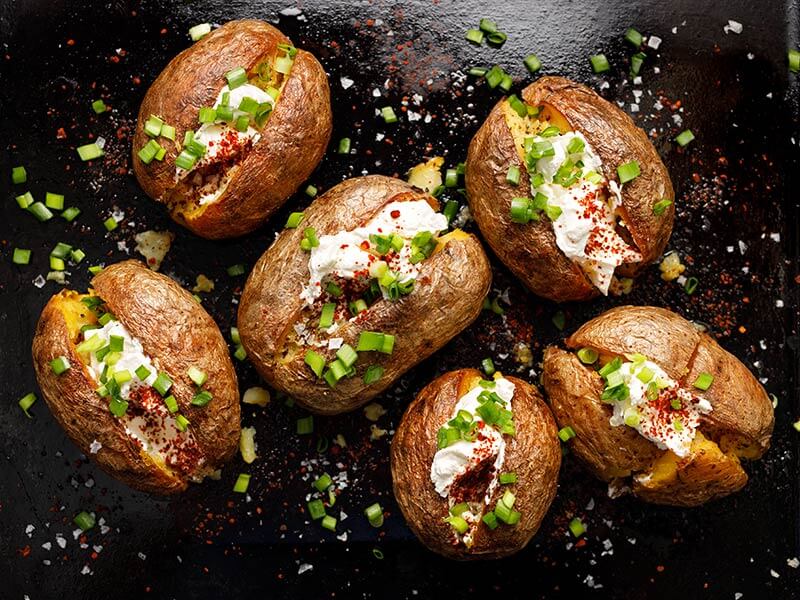
This step could be tricky since you don’t know if you should rub oil and salt on your potatoes before baking or not. You could either do this before baking or halfway in the process is fine.
Preferably, you should rub oil and season them after baking a bit. Usually, cooks will take out the half-baked potatoes and brush them with oil, then season with a pinch of salt or other ingredients like herbs, for example.
Different Ways & Times To Bake Potatoes At 350°F
Speaking of baked potatoes, I’ve got good news for you. Except for the trustworthy baking oven, you can utilize other cooking appliances such as the convenient microwave or your health-friendly air-fryer.
In Oven
There is not much to talk about this well-known baking machine since it’s available in almost any household nowadays. However, there are a few things you need to know before baking your potatoes in any kind of oven.
Step 1: Preheat
Always preheat your oven because you want the inside oven to be hot enough. Besides, you would save so much time waiting for your oven to heat up and do something else like prepare your potatoes.
Step 2: Prepare Your Potatoes
As instructed above, wash carefully and scrub them hard with your hands or vegetable brush for extra cleanness. After that, make a few holes in your potatoes with a fork, and you’ll see the surprise later.
Put those potatoes on the oven’s middle rack, then arrange them evenly. But remember to place one lower rack under to catch all the oily drips.
Step 3: Set Timer
Set the timer to 45 minutes and wait to see if those potatoes have any change during the baking process. It’s time for the next step.
Step 4: Turning Your Potatoes
Sounds familiar? That’s because any baking potato process has to have this step. This one step is to check whether your potatoes are overcooked or not.
More importantly, you must turn them over for them to cook evenly on both sides, plus you have to rub oil and season them with salt to have the extra crispy exteriors.
Once you’ve done that, keep baking them for another 15 minutes and check them regularly ‘till they look captivating with that brown color and gorgeous look outside. The whole process could take up to 60 minutes for every “check & turn,” so be patient!
In Microwave
If the oven is born for potatoes baking, then the microwave is a backup plan for those who are short on time. That is not to refuse the convenience and the quality that microwaves bring to your potatoes.
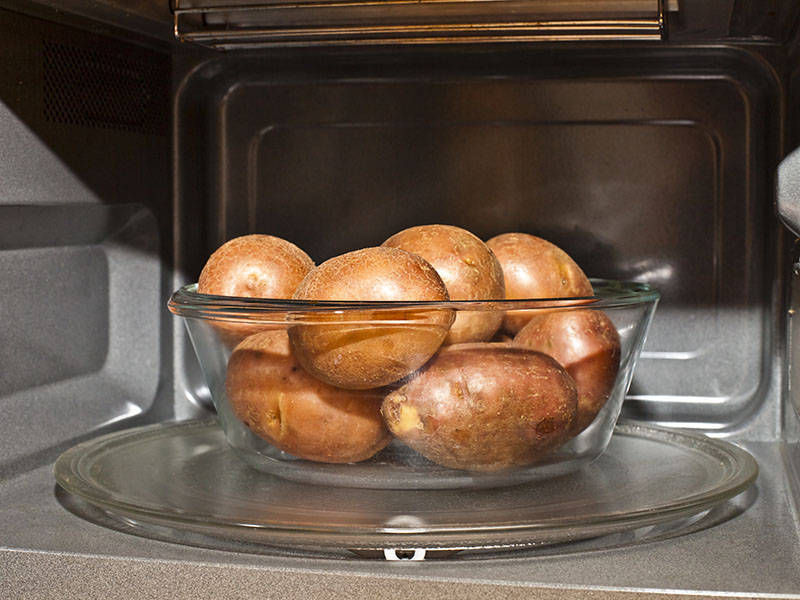
Step 1: Wash&Dry
Washing, as I mentioned before, is essential. What about drying? Drying is a way to control the moisture of your potatoes, drying and leaving them to rest for a while to have the best balance in the moisture level.
Keep in mind that once they’re dry, don’t do anything to increase the moisture as unnecessary as wrapping them in foil.
Step 2: Arrange Potatoes
Any microwave will have this specialized plate for you to put the foods on, so just simply cover the plate’s space with potatoes. And don’t forget the forking tips!
Step 3: Two-Steps Microwaving
There’s the same reason with oven-baking for this method’s name. You will, again, have to take your potatoes out halfway and make the “rubbing & seasoning” move.
Anyway, I should warn you not to hope for the perfect result because with the microwave, they’re more likely to steam your potatoes than bake them.
Step 4: Re-check
Re-check every 7 minutes of microwaving because you need to keep baking until you see they’re turning brown. That’s annoying about microwaving; the potatoes wouldn’t be as you expected.
Although you can bake potatoes in the microwave, I can’t promise the same result as in the oven. No crispy skin or cloud-fluffy texture is guaranteed since the microwave can bake fast; it could save time but not your appetite.
In Air-Fryer
Air-fryer is the closest thing to an oven you could have in terms of the quality, taste, and texture of your potatoes. So don’t worry if you have no ovens; an air fryer should do just as well.
Step 1: Preheat
Obviously, pre-warming your air-fryer basket first, but this is just optional since air-fryers are fast-cooking, and you can skip this step.
Step 2: Rubbing Oil
Throw in all of your potatoes, around ten if they are small, to the fullest of the basket’s capacity. Then, sprinkle them with salt and pepper and drizzle one or two spoons of olive oil.
Step 3: Timing
It usually takes around 30-40 minutes (much faster than the oven) to bake your potatoes at 350 Fahrenheit. However, the air-fryer is full of risks, from drying to overcooking or even burning the potatoes.
In short, you should be careful with this appliance and check on your potatoes even more often.
Take out your air-fryer and bake one big batch of potatoes for your family now!
How Can You Tell If Your Baked Potatoes Are Done?
Fork-tender is the keyword you’re looking for; I’m not talking about the “forking thing” before you bake potatoes to help moisture escape from your potatoes.
I’m talking about the time when you’re done baking. You use your fork or skewer or any pointy tool to insert into your potatoes and check for doneness. The resistance should feel as easy as your fork sliding into the potatoes effortlessly.
Sit Back And Relax While Baking The Best Potatoes With These Expert Tips
You probably notice that I’ve been giving you a few tricks throughout this article, right? I have some more tips for you, from forking to have a better texture to checking your potatoes’ doneness. Let’s check them out.
Choose Russet Potatoes For A Worthy Product
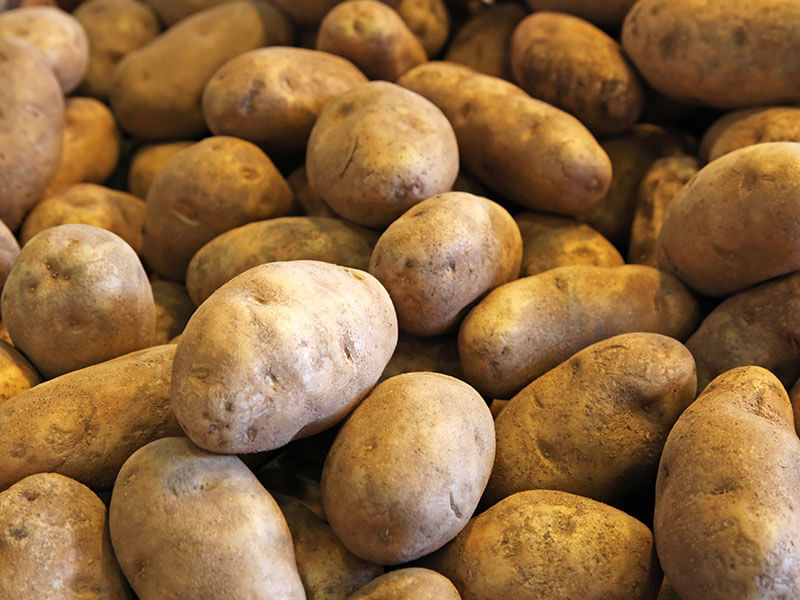
Well, there has got to be a reason for McDonald’s to use Russet Potatoes in their menu. They can make the perfect french fries, so why not the flawless baked potatoes?
By the way, Russet Potatoes’ natural texture and thick skin already help you do all the tricks. They are starchy for the tenderness and thick-skinned for better crispiness
Choose Potatoes Of Humble Size And Similar Size
Using humble-sized potatoes is a way to help you cook them faster since they’re smaller. Besides, you should use potatoes that are similar in size because that helps your potatoes cook evenly at the same time, and you don’t need to re-cook any undone potatoes.
Re-Buttering And Re-Seasoning For Crispy Skins
You should rub oil and salt & pepper seasoning every time you turn over your potatoes. The oil helps create a protective layer, preventing the skin from drying or burning in the baking process. Don’t hesitate to do these tricks the next time you bake your potatoes.
FAQs
In case you have more questions about how long to bake potatoes at 350. Check out the following questions that people used to ask and find out the answer to your problems.
Since You Know How To Bake The Best Potatoes, Why Hold Yourself Back?
Okay, that’s enough information to make you a professional potato baker. You’ve already known the time for different potatoes and appliances, set the temperature to 350°F, and cook a hearty meal full of baked potato dishes.
Thank you for reading the entire article. If you like this article and find it informative, leave a comment and share it with your friends and family. That is a great motivation for me to keep writing helpful articles like this. Goodbye, and see you soon!
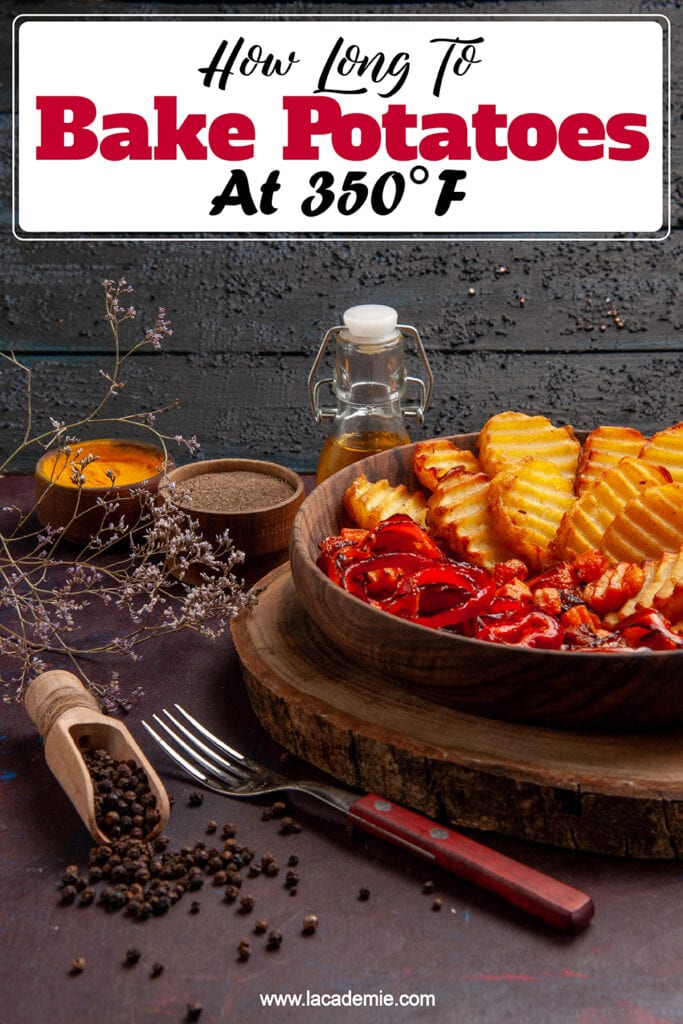
References
- Idaho® Potato Commission. 2022. Ideal temperature for a baked potato.
- Nutritionix.com. 2022. {{MetaTags.title || ‘Nutritionix’}}.
- En.wikipedia.org. 2022. Russet potato – Wikipedia.
- Nytimes.com. 2022. Deep Secrets: Making the Perfect Fry; The potato of the moment is often a soggy disappointment. Time to take things into your own hands. (Published 1999).

